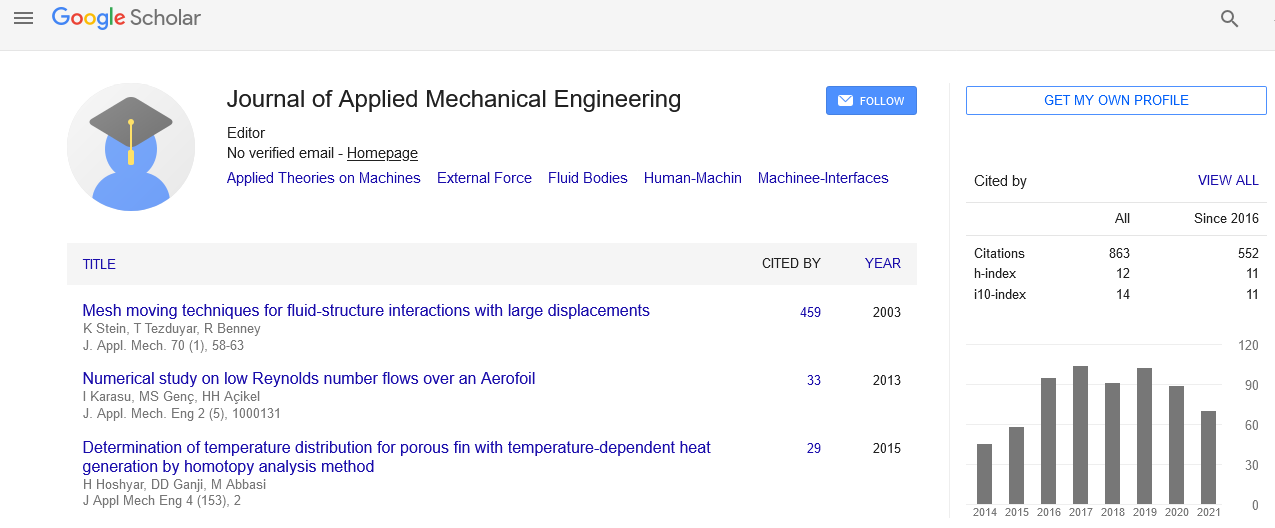Indexed In
- Genamics JournalSeek
- JournalTOCs
- CiteFactor
- RefSeek
- Hamdard University
- EBSCO A-Z
- OCLC- WorldCat
- Publons
- Google Scholar
Useful Links
Share This Page
Journal Flyer

Open Access Journals
- Agri and Aquaculture
- Biochemistry
- Bioinformatics & Systems Biology
- Business & Management
- Chemistry
- Clinical Sciences
- Engineering
- Food & Nutrition
- General Science
- Genetics & Molecular Biology
- Immunology & Microbiology
- Medical Sciences
- Neuroscience & Psychology
- Nursing & Health Care
- Pharmaceutical Sciences
Commentary - (2023) Volume 12, Issue 1
Features of Robotic Mechanisms Involved in Rapid Prototyping
Evelyn Kinfy*Received: 02-Jan-2023, Manuscript No. JAME-23-19988; Editor assigned: 04-Jan-2023, Pre QC No. JAME-23-19988 (PQ); Reviewed: 18-Jan-2023, QC No. JAME-23-19988; Revised: 23-Jan-2023, Manuscript No. JAME-23-19988 (R); Published: 03-Feb-2023, DOI: 10.35248/2168-9873.23.12.459
Description
Robotic manipulators are used for manipulating objects within confined spaces without any direct physical contact by the operator. Manipulators were originally designed for applications in hazardous and inaccessible environments. However, recent developments show its use in diverse applications, including both service and industrial applications. Robotic manipulators are replacing human operators to enable faster motions, perform monotonous tasks, attain improved accuracy and reduce production costs. It is prevalent to see robots performing repetitive tasks along pre-defined trajectories, especially in manufacturing, logistics and automobile industries. A manipulator generally consists of a sequence of rigid links interconnected by active or passive joints with an end effector attached to perform the desired task. The choice of a suitable manipulator design is essential to ensure a large workspace, carry high payloads, good positional accuracy and excellent dynamic performance for a conditioned application. This implies that the performance of the manipulator depends highly upon its architectural design.
Manufacturing industries prefer to have modern manipulators to be reprogrammable and suitable for multi-purpose applications. Reprogrammable robots allow switching from one application to another by simply replacing the end effector. Robotic technologies are further expanding to involve human interaction with robots, particularly in surgical procedures, human body scanning, rehabilitation, pick and place operations, etc. Other specialized applications for robotic manipulators include quality checks in manufacturing, textile, pharmaceutical, food industries, teleoperated robots in nuclear and hazardous environments, material handling, sorting and packaging applications. Robotic manipulators will involve independent control of all the active joints to execute a specific motion for the end effector. The motion control requires coordination between the physical architecture of the mechanism, actuators and sensors.
Robotic manipulators are classified into serial or open chain mechanisms, parallel or closed chain mechanisms and hybrid mechanisms. Each classification of robotic manipulators has its own merits and demerits. The robot mechanism selection depends highly upon its application, the desired level of accuracy and the desired mobility. As the name suggests, serial manipulators have each link connected in series through prismatic (translational) or revolute (rotational) joints. For such mechanisms, the total Degree of Freedom (DoF) is equivalent to the number of joints present within the chain and its end effector is located at the free end. On the other hand, in parallel mechanisms, the end effector platform and the base are connected by several legs in parallel. In other words, parallel manipulators use several serial chains to support a single platform or the end-effector.
The DoF for such mechanisms is less than the number of joints due to the constraints imposed from multiple legs. The third classification of manipulators, namely, the hybrid manipulator, is a combination of both serial and parallel manipulator. It is theoretically assumed that hybrid manipulators exhibit the benefits of both serial and parallel configurations. The sequence of arrangements at every link and joint decides the motion of the end-effector. Since the end-effector is constrained by more than one leg in parallel and hybrid configurations, the manipulator architecture plays a critical role in deciding the output motion.
Conclusion
Depending upon the classification of robotic manipulators based on their construction, it is evident that serial manipulators offer the maximum workspace due to their least constraint. However, it is widely observed that serial manipulators suffer from additive errors from each link, carry lesser payloads, support motor or other drives at every joint causing inertia effects and have reduced precision compared to parallel manipulators.
Citation: Kinfy E (2023) Features of Robotic Mechanisms involved in Rapid Prototyping. J Appl Mech Eng. 12:459.
Copyright: © 2023 Kinfy E. This is an open-access article distributed under the terms of the Creative Commons Attribution License, which permits unrestricted use, distribution, and reproduction in any medium, provided the original author and source are credited.

